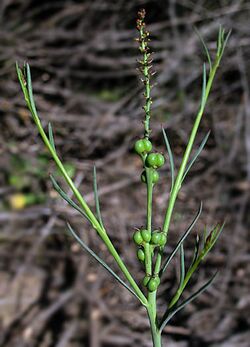Biology:Stillingia linearifolia
| Stillingia linearifolia | |
|---|---|

| |
| Scientific classification | |
| Kingdom: | Plantae |
| Clade: | Tracheophytes |
| Clade: | Angiosperms |
| Clade: | Eudicots |
| Clade: | Rosids |
| Order: | Malpighiales |
| Family: | Euphorbiaceae |
| Genus: | Stillingia |
| Species: | S. linearifolia
|
| Binomial name | |
| Stillingia linearifolia S.Watson
| |
Stillingia linearifolia is a species of flowering plant in the euphorb family known as queen's-root.[1]
It is native to the Southwestern United States, Southern California, and Northwestern Mexico, where it occurs in several types of dry and disturbed habitat in deserts, mountains, foothills, and chaparral.[2][3]
Description
Stillingia linearifolia is a perennial herb producing a clump of slender, branching, erect stems approaching 70 centimeters in height. The alternately arranged leaves are linear and narrow, reaching 4 centimeters in length but less than 2 millimeters in width.
The inflorescence is an erect spike of flowers a few centimeters long. The plant is monoecious, and each spike has several male flowers at the tip and a few fruit-bearing female flowers below these. Neither type of flower has petals. The ovary of the female flower develops into a three-lobed greenish capsule 3 to 4 millimeters wide.
There is a tiny black seed in each of the three chambers of the fruit.
See also
References
- ↑ "Stillingia linearifolia". Natural Resources Conservation Service PLANTS Database. USDA. https://plants.usda.gov/core/profile?symbol=STLI3. Retrieved 3 December 2015.
- ↑ USDA
- ↑ Jepson
External links
Wikidata ☰ Q7617245 entry
 |

